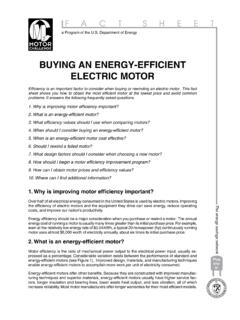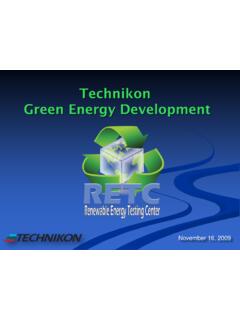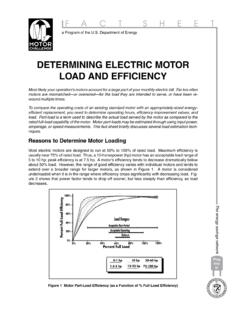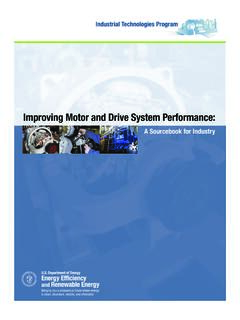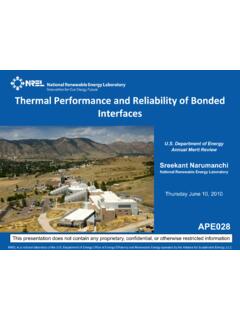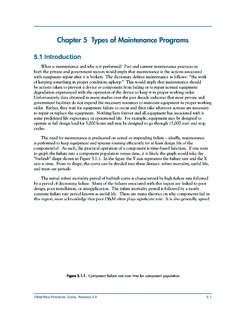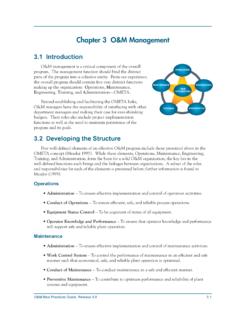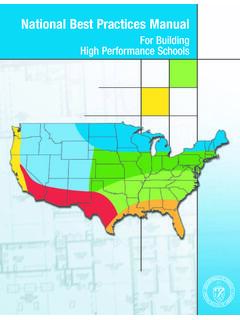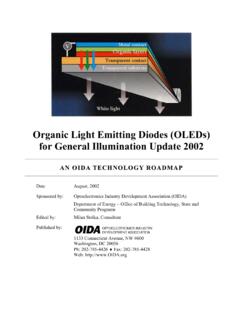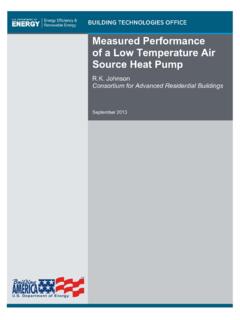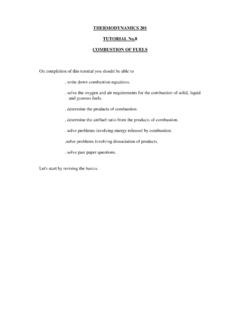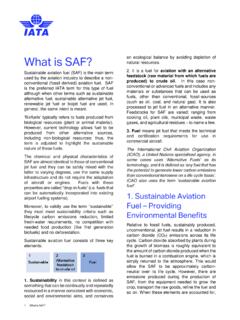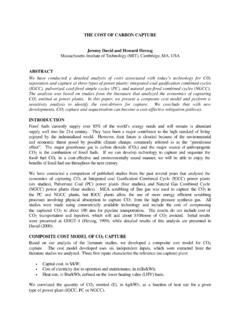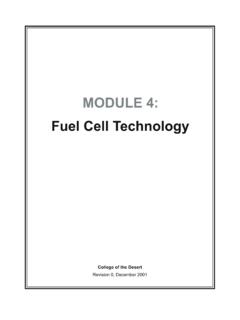Transcription of A Comparison of Hydrogen and Propane Fuels (Brochure)
1 DOE Hydrogen Program A Comparison of Hydrogen and Propane Fuels H. ydrogen and Propane have long histories of being used NREL/PIX 11599. as fuel . Both Fuels can be used safely if their physical, chemical, and thermal properties are understood and if appropriate codes, standards, and guidelines are followed. Although the properties of Hydrogen have been compared to those of Propane and methane, these comparisons were made to facilitate appreciation of the physical and chemical differences and similarities among these Fuels . It is not possible to rank these Fuels according to safety because plausible accident scenarios can be formulated in which any one of the Fuels can be considered the safest or the most hazardous.
2 Propane powered shuttle bus in Zion National Park Background Both Hydrogen and Propane have been used as Fuels for decades. In the 19th century, coal gas, a mixture containing about NREL/PIX 15718. 50% Hydrogen , 26% methane, and other gases, including 7% carbon monoxide, was used extensively in Great Britain for lighting. In the United States prior to World War II, town gas, . a 50/50 mixture of Hydrogen and carbon monoxide made by gasifying coal, was used by millions of Americans to cook food, light lamps, and heat water and homes. Propane was discovered . in 1910 as a component of gasoline in a Model T Ford and was first used largely for industrial purposes, such as blowtorches to cut metals.
3 (National Propane Gas Association, ). Propane AC Transit's Hydrogen fuel Cell-Hybrid Electric Drive Bus Today more than 15 billion gallons of Propane are consumed annually for home, agricultural, industrial, and commercial uses. foods. Most of this Hydrogen is produced in just three states: Excluding Propane gas grills, residential and commercial use California, Louisiana, and Texas ( ). Almost accounts for about 45% of this consumption. About 38% is used all of the Hydrogen used is captive, that is, consumed at the in the petrochemical industry as a raw material to make plastics refinery or chemical plant where it is produced.
4 Nevertheless, and other items. While transportation represents the smallest a safe and reliable Hydrogen distribution network has been sector using Propane , Propane is still the most common alternative developed over the years, consisting of liquid Hydrogen delivery transportation fuel in use today. ( Propane Education and Research trucks, gaseous Hydrogen tube trailers, and dedicated gaseous Council, ) Hydrogen pipelines. Worldwide, there are over 800 km of Hydrogen pipelines, including 225 km in the Ruhr Valley of Hydrogen Germany that have operated safely since 1938, and over 200. About million metric tons ( billion pounds) of Hydrogen km of Hydrogen pipeline in the United States, primarily in the are produced in the United States today, enough to power 20-30 Texas Gulf Coast area.
5 Both liquid and gaseous Hydrogen are million cars or 5-8 million homes. Nearly all of this Hydrogen distributed throughout the United States in hundreds of tanker is used by industry in refining, treating metals, and processing trucks and tube trailers. ( ). Department of Energy Hydrogen Program A Comparison of Hydrogen and Propane Fuels Basic Properties of Hydrogen , Methane, and Propane Gas Properties: Hydrogen Methane Propane Chemical Formula H2 CH4 C3H8. Molecular Weight Gas Density (kg/m3) @ STP Diffusivity (m2/sec) x 105 combustion Properties: Stoichiometric fuel Volume Fraction % Lower Heating Value (MJ/m3) Lower Heating Value (MJ/kg) Adiabatic Flame Temperature (K) 2380 2226 2267.
6 Flammability Limits (Volume %). Lean Limit: 4% Rich Limit: 75% 15% Max. Flame Velocity (m/sec) Min. Ignition Temperature (K)1 845 905 766. Min. Ignition Energy (10-5 J)1 33 Storage Conditions: Tank Type Cylinder Cylinder Barbecue Volume (liters) 49 49 21. Pressure (psi)2 34 MPa 17 MPa MPa Phase Gas Gas Liquid Mass (kg) 1 At stoichiometric conditions 2 Pressure conversions: 5000 psi = 34 MPa; 2500 psi = MPa; 240 psi = MPa Source: Robert Schefer, Sandia National Laboratory Ignition and combustion If there is a brief leak, Hydrogen , being more buoyant, will rise For example, Propane can ignite when the mixture is 3%. more rapidly than either Propane or methane vapor and will Propane , whereas Hydrogen or methane at the same fuel -air quickly disperse.
7 A rapid dispersion rate is probably Hydrogen 's mixture will not ignite. greatest safety asset in an outdoor environment, although wind Once ignited, the adiabatic flame temperatures of Hydrogen , and the escape velocity from a high-pressure tank may have more methane, and Propane differ very little in stoichiometric mix- influence on the size of a flammable Hydrogen cloud. Indoors, tures with air. The hazards related to high flame temperatures high dispersion rates can be both an asset, in the sense that a are almost the same for all of these Fuels . The emissivity of a small leak will rapidly mix with air and stay below the lean flame influences the total flux of heat radiated.
8 The low flame flammability limit, and a potential liability in a larger leak the emissivity of Hydrogen reduces the heat transferred by radia- expanding gas cloud is more likely to reach ignition sources. tion to objects near the flame and reduces the risks of secondary The wide flammability range of Hydrogen -air mixtures compared ignitions and burns. In other words, Hydrogen flames radiate less to the other Fuels is a disadvantage. For example, Hydrogen can heat than hydrocarbon-based Fuels . Most accidental hydrocarbon ignite when the mixture is 50% Hydrogen (with air), whereas flames, such as those from Propane , natural gas, and gasoline, methane or Propane at the same fuel -air mixture cannot.
9 Also contain soot that increases the amount of heat radiated. Since the fuel concentration in air builds up from zero in most A Hydrogen flame is invisible in daylight and emits a low level accidents with brief releases, ignition is most likely to occur of thermal radiation. Even if location is known, the envelope of when the fuel concentration first reaches the lean flammability the flame is not always easily distinguishable. In the Hydrogen limit. The lean flammability limit for Hydrogen , while slightly industry, fixed and portable optical detectors are widely used to lower than methane, is twice that of Propane . detect Hydrogen fires.
10 A Comparison of Hydrogen and Propane Fuels NREL/PIX 02903. Deflagration and Detonation During combustion , flames can propagate through a flammable fuel -air mixture as either a deflagration or a detonation, depending on a complex interaction among factors such as the composition iStockphoto 6189300. of the gas mixture, the ignition source and energy, the geometry of the surroundings, and the degree of confinement of the mixture (Beauvais et al. 1993). Deflagration, or simple combustion , is propagated through the flammable mixture by heat transfer and transfer of free radicals to the reactant gases ahead of the flame front at subsonic velocities.
